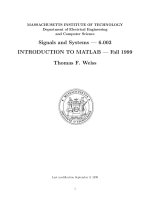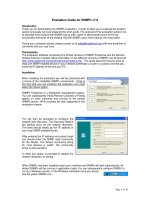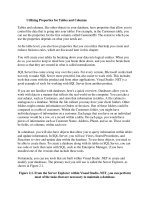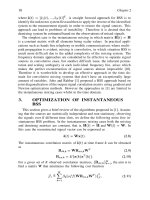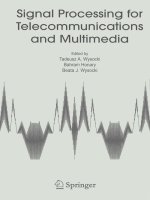Tài liệu Pocket Guide for Fundamentals and GSM Testing pdf
Bạn đang xem bản rút gọn của tài liệu. Xem và tải ngay bản đầy đủ của tài liệu tại đây (850 KB, 54 trang )
Pocket Guide for Fundamentals and GSM Testing
Publisher: Wandel & Goltermann GmbH & Co
Elektronische Meûtechnik
P. O. Box 12 62
D-72795 Eningen u.A.
Germany
e-mail:
Author: Marc Kahabka
CONTENTS
1 ªMobilityº ± The magic word . . . . . . . . . . . . . . . . . . . . . . . . . 3
2 GSM overview . . . . . . . . . . . . . . . . . . . . . . . . . . . . . . . . . . . 5
3 GSM system architecture . . . . . . . . . . . . . . . . . . . . . . . . . . . . 7
4 Interfaces and protocols . . . . . . . . . . . . . . . . . . . . . . . . . . . . 11
5 The air interface U
m
................................13
5.1 Logical channels on the air interface . . . . . . . . . . . . . . . . . 15
5.2 Traffic channels on the air interface . . . . . . . . . . . . . . . . . . 17
5.3 Signaling channels on the air interface . . . . . . . . . . . . . . . 18
5.4 Burst formats . . . . . . . . . . . . . . . . . . . . . . . . . . . . . . . . . . 20
5.5 Protocols on the air interface . . . . . . . . . . . . . . . . . . . . . . 22
6 The A
bis
interface . . . . . . . . . . . . . . . . . . . . . . . . . . . . . . . . . 24
6.1 The TRAU frame . . . . . . . . . . . . . . . . . . . . . . . . . . . . . . . 26
6.2 Protocols on the A
bis
interface . . . . . . . . . . . . . . . . . . . . . 28
7 The A interface . . . . . . . . . . . . . . . . . . . . . . . . . . . . . . . . . . . 30
7.1 Protocols on the A interface . . . . . . . . . . . . . . . . . . . . . . . 30
8 MSC-based interfaces . . . . . . . . . . . . . . . . . . . . . . . . . . . . . . 32
8.1 MSC protocols . . . . . . . . . . . . . . . . . . . . . . . . . . . . . . . . 33
9 Call setup . . . . . . . . . . . . . . . . . .. . . . . . . . . . . . . . . . . . . . . 35
10 Test and measurement problems in GSM . . . . . . . . . . . . . . . . 37
11 Outlook . . . . . . . . . . . . . . . . . . . . . . . . . . . . . . . . . . . . . . . . 46
12 GSM glossary . . . . . . . . . . . . . . . . . . . . . . . . . . . . . . . . . . . . 47
13 Bibliography . . . . . . . . . . . . . . . . . . . . . . . . . . . . . . . . . . . . . 51
1
2
1 ªMobilityª ±
The magic word
Hard to fathom, but it really wasn't all that long ago that even a plain
old telephone was a luxury item. But, as we all know, technology's only
constant is change. In this day and age, many folks need to be access-
ible everywhere, whether they're at work or play, in the office or at
home. To meet this demand, the GSM standard (Global System for Mo-
bile Communications) for mobile telephony was introduced in the mid-
1980s. Today, GSM is the most popular mobile radio standard in the
world. A boom is underway, such that many GSM users find life without
their phone practically inconceivable.
Nowadays, when we speak of GSM, we usually mean ªoriginalº GSM ±
also known as GSM900 since 900 MHz was the original frequency
band. To provide additional capacity and enable higher subscriber den-
sities, two other systems were added later: GSM1800 (also DCS1800)
and GSM1900 (also PCS 900). Compared to GSM 900, GSM1800 and
GSM1900 differ primarily in the air interface. Besides using another fre-
quency band, they use a microcellular structure (i.e. a smaller coverage
region for each radio cell). This makes it possible to reuse frequencies
at closer distances, enabling an increase in subscriber density. The dis-
advantage is the higher attenuation of the air interface due to the higher
frequency. The rest of this booklet will mainly focus on GSM900.
Where now? A few years ago, Michael Jackson sang ª. . . just call my
name and I'll be thereº. While this might seem inconceivable now, it
might become reality sooner than we think, given the rapid pace of
technological evolution. Faced with a whirlwind of speculation, ETSI
3
(the telecom standardization authority in Europe) decided to base the
air interface of the planned universal mobile telecommunications sys-
tem (UMTS) on a mix of WCDMA and TD/CDMA technologies. The in-
frastructure of the existing GSM networks will most likely be used.
This booklet is intended to provide communications engineers & techni-
cians with basic information about the GSM system ± a starting point
for further study of any given area. A word of warning: Look further if
you need complete GSM system specifications. Research sources are
listed in the appendix. Also: This booklet assumes you, the reader, have
a basic understanding of telecommunications technology.
Enjoy!
Marc Kahabka
4
2 GSM overview
Fig. 1: The Mobile Evolution
Before GSM networks there were public mobile radio networks (cellu-
lar). They normally used analog technologies, which varied from country
to country and from manufacturer to another. These analog networks
5
did not comply with any uniform standard. There was no way to use a
single mobile phone from one country to another. The speech quality in
most networks was not satisfactory.
GSM became popular very quickly because it provided improved speech
quality and, through a uniform international standard, made it possible to
use a single telephone number and mobile unit around the world. The
European Telecommunications Standardization Institute (ETSI) adopted
the GSM standard in 1991, and GSM is now used in 135 countries.
The benefits of GSM include:
± Support for international roaming
± Distinction between user and device identification
± Excellent speech quality
± Wide range of services
± Interworking (e.g. with ISDN, DECT)
± Extensive security features
GSM also stands out from other technologies with its wide range of
services
1
:
± Telephony
± Asynchronous and synchronous data services (2.4/4.8/9.6 kbit/s)
± Access to packet data network (X.25)
± Telematic services (SMS, fax, videotext, etc.)
± Many value-added features (call forwarding, caller ID, voice mailbox)
± E-mail and Internet connections
1
Available services vary from operator to operator
6
3 GSM system
architecture
Fig. 2
The best way to create a manageable communications system is to
divide it into various subgroups that are interconnected using
standardized interfaces. A GSM network can be divided into three
groups (see Fig. 2): The mobile station (MS), the base station
subsystem (BSS) and the network subsystem.
7
They are characterized as follows:
The mobile station
(MS)
A mobile station may be referred to as a ªhandsetº, a ªmobileº, a ªport-
able terminalº or ªmobile equipmentº ME). It also includes a subscriber
identity module (SIM) that is normally removable and comes in two
sizes. Each SIM card has a unique identification number called IMSI
(international mobile subscriber identity). In addition, each MS is as-
signed a unique hardware identification called IMEI (international mobile
equipment identity).
In some of the newer applications (data communications in particular),
an MS can also be a terminal that acts as a GSM interface, e.g. for
a laptop computer. In this new application the MS does not look like a
normal GSM telephone.
The seemingly low price of a mobile phone can give the (false) impres-
sion that the product is not of high quality. Besides providing a trans-
ceiver (TRX) for transmission and reception of voice and data, the
mobile also performs a number of very demanding tasks such as
authentication, handover, encoding and channel encoding.
The base station
subsystem (BSS)
The base station subsystem (BSS) is made up of the base station
controller (BSC) and the base transceiver station (BTS).
The base transceiver station (BTS): GSM uses a series of radio trans-
mitters called BTSs to connect the mobiles to a cellular network. Their
tasks include channel coding/decoding and encryption/decryption. A
BTS is comprised of radio transmitters and receivers, antennas, the in-
terface to the PCM facility, etc. The BTS may contain one or more
8
transceivers to provide the required call handling capacity. A cell site
may be omnidirectional or split into typically three directional cells.
.
The base station controller (BSC): A group of BTSs are connected
to a particular BSC which manages the radio resources for them.
Today's new and intelligent BTSs have taken over many tasks that
were previously handled by the BSCs.
The primary function of the BSC is call maintenance. The mobile sta-
tions normally send a report of their received signal strength to the
BSC every 480 ms. With this information the BSC decides to initiate
handovers to other cells, change the BTS transmitter power, etc.
The network
subsystem
.
The mobile switching center (MSC): Acts like a standard exchange
in a fixed network and additionally provides all the functionality
needed to handle a mobile subscriber. The main functions are regis-
tration, authentication, location updating, handovers and call routing
to a roaming subscriber. The signaling between functional entities
(registers) in the network subsystem uses Signaling System 7 (SS7).
If the MSC also has a gateway function for communicating with other
networks, it is called Gateway MSC (GMSC).
.
The home location register (HLR): A database used for management of
mobile subscribers. It stores the international mobile subscriber identity
(IMSI), mobile station ISDN number (MSISDN) and current visitor location
register (VLR) address. The main information stored there concerns the
location of each mobile station in order to be able to route calls to the mo-
bile subscribers managed by each HLR. The HLR also maintains the ser-
vices associated with each MS. One HLR can serve several MSCs.
9
.
The visitor location register (VLR): Contains the current location of
the MS and selected administrative information from the HLR, neces-
sary for call control and provision of the subscribed services, for each
mobile currently located in the geographical area controlled by the
VLR. A VLR is connected to one MSC and is normally integrated into
the MSC's hardware.
.
The authentication center (AuC): A protected database that holds a
copy of the secret key stored in each subscriber's SIM card, which is
used for authentication and encryption over the radio channel. The
AuC provides additional security against fraud. It is normally located
close to each HLR within a GSM network.
.
The equipment identity register (EIR): The EIR is a database that
contains a list of all valid mobile station equipment within the net-
work, where each mobile station is identified by its international mo-
bile equipment identity (IMEI). The EIR has three databases:
± White list: for all known, good IMEIs
± Black list: for bad or stolen handsets
± Grey list: for handsets/IMEIs that are uncertain
Operation and
Maintenance Center
(OMC)
The OMC is a management system that oversees the GSM functional
blocks. The OMC assists the network operator in maintaining satisfac-
tory operation of the GSM network. Hardware redundancy and intelli-
gent error detection mechanisms help prevent network down-time. The
OMC is responsible for controlling and maintaining the MSC, BSC and
BTS. It can be in charge of an entire public land mobile network (PLMN)
or just some parts of the PLMN.
10
4 Interfaces and
protocols
Fig. 3: OSI Layer structure
in GSM
Note: Numbers in parentheses indicate the relevant
ETSI-GSM Recommendations.
Providing voice or data transmission quality over the radio link is only
part of the function of a cellular mobile network. A GSM mobile can
seamlessly roam nationally and internationally, requiring standardized
call routing and location updating functions in GSM networks. A public
communications system also needs solid security mechanisms to pre-
vent misuse by third parties. Security functions such as authentication,
encryption and the use of Temporary Mobile Subscriber Identities
(TMSIs) are an absolute must.
11
Within a GSM network, different protocols are needed to enable the
flow of data and signaling between different GSM subsystems.
Figure 3 shows the interfaces that link the different GSM subsystems
and the protocols used to communicate on each interface.
GSM protocols are basically divided into three layers:
.
Layer 1: Physical layer
± Enables physical transmission (TDMA, FDMA, etc.)
± Assessment of channel quality
± Except on the air interface (GSM Rec. 04.04), PCM 30 or ISDN
links are used (GSM Rec. 08.54 on A
bis
interface and 08.04 on
A to F interfaces).
.
Layer 2: Data link layer
± Multiplexing of one or more layer 2 connections
on control/signaling channels
± Error detection (based on HDLC)
± Flow control
± Transmission quality assurance
± Routing
.
Layer 3: Network layer
± Connection management (air interface)
± Management of location data
± Subscriber identification
± Management of added services (SMS, call forwarding, conference
calls, etc.)
12
5 The air
interface U
m
Fig. 4: GSM Air Interface,
TDMA frame
The International Telecommunication Union (ITU), which manages inter-
national allocation of radio spectrum (among many other functions), has
allocated the following bands:
GSM900:
Uplink: 890±915 MHz (= mobile station to base station)
Downlink: 935±960 MHz (= base station to mobile station).
13
GSM1800 (previously: DCS-1800):
Uplink: 1710±1785 MHz
Downlink: 1805±1880 MHz
GSM1900 (previously: PCS-1900):
Uplink: 1850±1910 MHz
Downlink: 1930±1990 MHz
The air interface for GSM is known as the U
m
interface.
Since radio spectrum is a limited resource shared by all users, a
method was devised to divide the bandwidth among as many users as
possible. The method chosen by GSM is a combination of time- and
frequency-division multiple access (TDMA/FDMA). The FDMA part
involves the division by frequency of the (maximum) 25 MHz allocated
bandwidth into 124 carrier frequencies spaced 200 kHz apart. One or
more carrier frequencies are assigned to each base station. Each of
these carrier frequencies is then divided in time, using a TDMA scheme.
The fundamental unit of time in this TDMA scheme is called a burst
period and it lasts approx. 0.577 ms. Eight burst periods are grouped
into a TDMA frame (approx. 4.615 ms), which forms the basic unit for
the definition of logical channels. One physical channel is one burst
period per TDMA frame.
14
5.1 Logical channels
on the air inter-
face
Fig. 5: GSM Air Interface,
logical channels
15
Several logical channels are mapped onto the physical channels. The
organization of logical channels depends on the application and the
direction of information flow (uplink/downlink or bidirectional). A logical
channel can be either a traffic channel (TCH), which carries user data,
or a signaling channel (see following chapters).
Fig. 6
16
5.2 Traffic channels
on the air inter-
face
A traffic channel (TCH) is used to carry speech and data traffic. Traffic
channels are defined using a 26-frame multiframe, or group of 26 TDMA
frames. The length of a 26-frame multiframe is 120 ms, which is how
the length of a burst period is defined (120 ms divided by 26 frames
divided by 8 burst periods per frame). Out of the 26 frames, 24 are
used for traffic, 1 is used for the slow associated control channel
(SACCH) and 1 is currently unused (see Fig. 5). TCHs for the uplink and
downlink are separated in time by 3 burst periods, so that the mobile
station does not have to transmit and receive simultaneously, thereby
simplifying the electronic circuitry. This method permits complex an-
tenna duplex filters to be avoided and thus helps to cut power con-
sumption.
In addition to these full-rate TCHs (TCH/F, 22.8 kbit/s), half-rate TCHs
(TCH/H, 11.4 kbit/s) are also defined. Half-rate TCHs double the capa-
city of a system effectively by making it possible to transmit two calls
in a single channel. If a TCH/F is used for data communications, the
usable data rate drops to 9.6 kbit/s (in TCH/H: max. 4.8 kbit/s) due to
the enhanced security algorithms. Eighth-rate TCHs are also specified,
and are used for signaling. In the GSM Recommendations, they are
called stand-alone dedicated control channels (SDCCH).
17
5.3 Signaling
channels on the
air interface
The signaling channels on the air interface are used for call establish-
ment, paging, call maintenance, synchronization, etc. There are 3 groups
of signaling channels:
.
The broadcast channels (BCH): Carry only downlink information
and are responsible mainly for synchronization and frequency correc-
tion. This is the only channel type enabling point-to-multipoint com-
munications in which short messages are simultaneously transmitted
to several mobiles.
The BCHs include the following channels:
± The broadcast control channel (BCCH): General information, cell-
specific; e.g. local area code (LAC), network operator, access
parameters, list of neighboring cells, etc. The MS receives signals
via the BCCH from many BTSs within the same network and/or
different networks.
± The frequency correction channel (FCCH): Downlink only; correc-
tion of MS frequencies; transmission of frequency standard to MS;
it is also used for synchronization of an acquisition by providing
the boundaries between timeslots and the position of the first time-
slot of a TDMA frame.
± The synchronization channel (SCH): Downlink only; frame syn-
chronization (TDMA frame number) and identification of base
station. The valid reception of one SCH burst will provide the MS
with all the information needed to synchronize with a BTS.
18
.
The common control channels (CCCH): A group of uplink and
downlink channels between the MS card and the BTS. These chan-
nels are used to convey information from the network to MSs and
provide access to the network. The CCCHs include the following
channels:
± The paging channel (PCH): Downlink only; the MS is informed by
the BTS for incoming calls via the PCH.
± The access grant channel (AGCH): Downlink only; BTS allocates a
TCH or SDCCH to the MS, thus allowing the MS access to the
network.
± The random access channel (RACH): Uplink only; allows the MS
to request an SDCCH in response to a page or due to a call; the
MS chooses a random time to send on this channel. This creates
a possibility of collisions with transmissions from other MSs.
The PCH and AGCH are transmitted in one channel called the paging
and access grant channel (PAGCH). They are separated by time.
.
The dedicated control channels (DCCH): Responsible for e.g.
roaming, handovers, encryption, etc.
The DCCHs include the following channels:
± The stand-alone dedicated control channel (SDCCH): Communica-
tions channel between MS and the BTS; signaling during call setup
before a traffic channel (TCH) is allocated;
± The slow associated control channel (SACCH): Transmits continu-
ous measurement reports (e.g. field strengths) in parallel to oper-
19
ation of a TCH or SDCCH; needed, e.g. for handover decisions; al-
ways allocated to a TCH or SDCCH; needed for ªnon-urgentº pro-
cedures, e. g. for radio measurement data, power control (downlink
only), timing advance, etc.; always used in parallel to a TCH or
SDCCH.
± The fast associated control channel (FACCH): Similar to the
SDCCH, but used in parallel to operation of the TCH; if the data
rate of the SACCH is insufficient, ªborrowing modeº is used:
Additional bandwidth is borrowed from the TCH; this happens for
messages associated with call establishment authentication of the
subscriber, handover decisions, etc.
Almost all of the signaling channels use the ªnormal burstº format
(see section 5.4 Burst formats), except for the RACH (Random Access
Burst), FCCH (Frequency Correction Burst) and SCH (SynCHronization
Burst) channels.
5.4 Burst formats A timeslot is a 576 ms time interval, i.e. 156.25 bits duration, and its
physical contents are known as a burst. Five different types of bursts
exist in the system. They are distinguished by different TDMA frame
divisions.
The normal burst (NB): Used to carry information on traffic and control
channels, except for RACH. It contains 116 encrypted bits.
The frequency correction burst (FB): Used for frequency synchroniza-
tion of the mobile. The contents of this burst are used to calculate an
20
unmodulated, sinusoidal oscillation, onto which the synthesizer of the
mobiles is clocked.
The synchronization burst (SB): Used for time synchronization of the
mobile. It contains a long training sequence and carries the information
of a TDMA frame number.
The access burst (AB): Used for random access and characterized
by a longer guard period (256 ms) to allow for burst transmission from
a mobile that does not know the correct timing advance at the first
access to a network (or after handover).
The dummy burst (DB): Transmitted as a filler in unused timeslots of
the carrier; does not carry any information but has the same format as
a normal burst (NB).
21
5.5 Protocols on the
air interface
.
Layer 1 (GSM Rec. 04.04): The physical properties of the U
m
inter-
face have already been described.
.
Layer 2 (GSM Rec. 04.05/06): Here, the LAP-Dm protocol is used
(similar to ISDN LAP-D). LAP-Dm has the following functions:
± Connectionless transfer on point-to-point and point-to-multipoint
signaling channels,
± Setup and take-down of layer 2 connections on point-to-point
signaling channels,
± Connection-oriented transfer with retention of the transmission
sequence, error detection and error correction.
.
Layer 3 (GSM Rec. 04.07/08): Contains the following sublayers which
control signaling channel functions (BCH, CCCH and DCCH):
± Radio resource management (RR): The role of the RR manage-
ment layer is to establish and release stable connection between
mobile stations (MS) and an MSC for the duration of a call, and to
maintain it despite user movements. The following functions are
performed by the MSC:
± Cell selection,
± Handover,
± Allocation and take-down of point-to-point channels,
± Monitoring and forwarding of radio connections,
± Introduction of encryption,
± Change in transmission mode.
22
± Mobility management (MM) handles the control functions
required for mobility, e.g.:
± Authentication,
± Assignment of TMSI,
± Management of subscriber location.
± Connection management (CM) is used to set up, maintain and
take down calls connections; it is comprised of three subgroups:
± Call control (CC): Manages call connections,
± Supplementary service support (SS): Handles special services,
± Short message service support (SMS): Transfers brief texts.
Neither the BTS nor the BSC interpret CM and MM messages. They
are simply exchanged with the MSC or the MS using the direct transfer
application part (DTAP) protocol on the A interface. RR messages are
mapped to or from the base station system application part (BSSAP) in
the BSCREF for exchange with the MSC.
23
